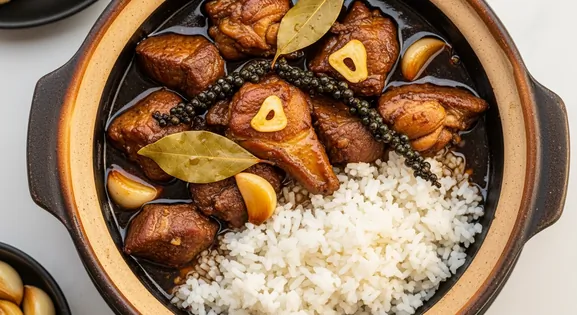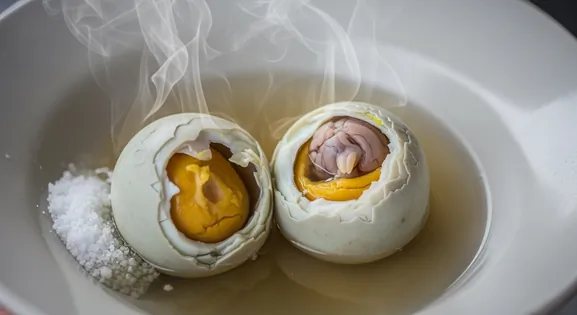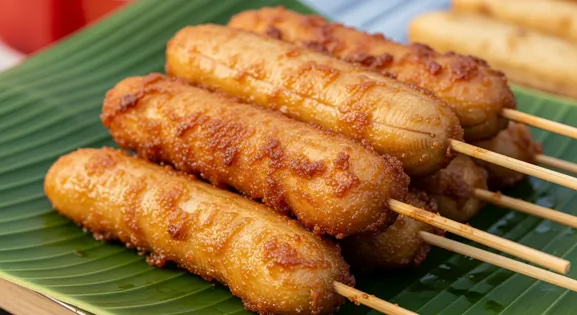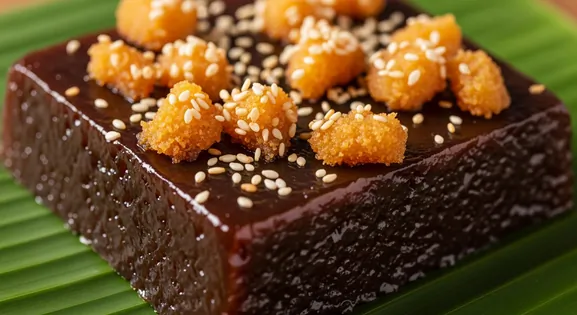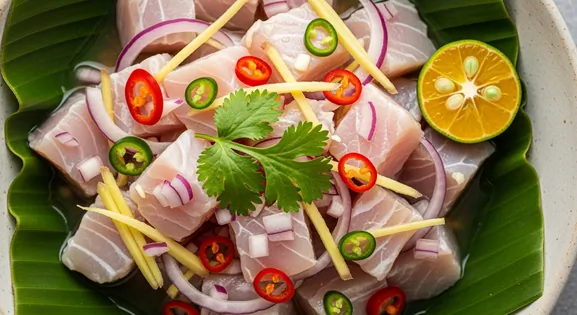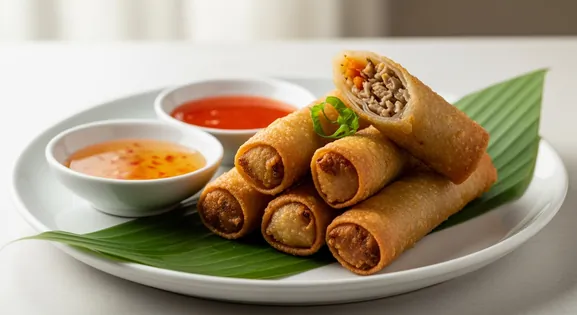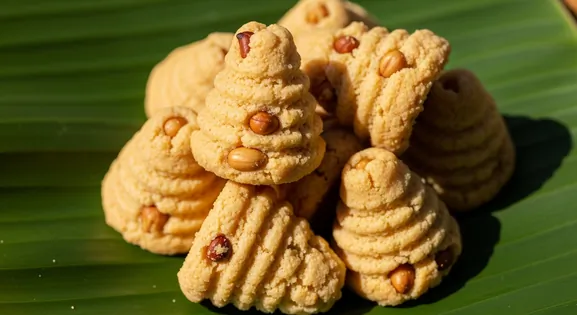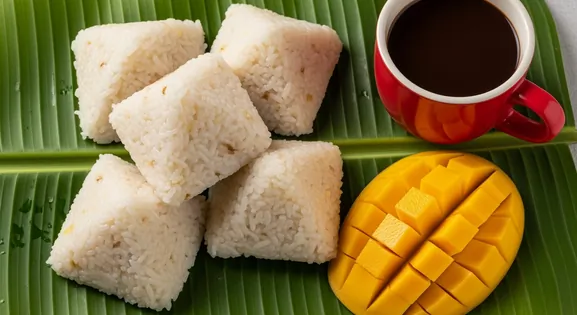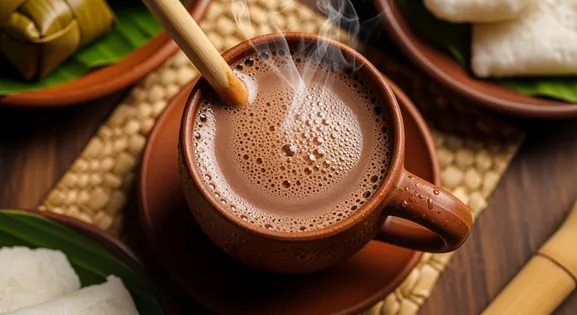Lechon in Philippines: A Complete Food Lover's Guide
Lechon Baboy / Litson
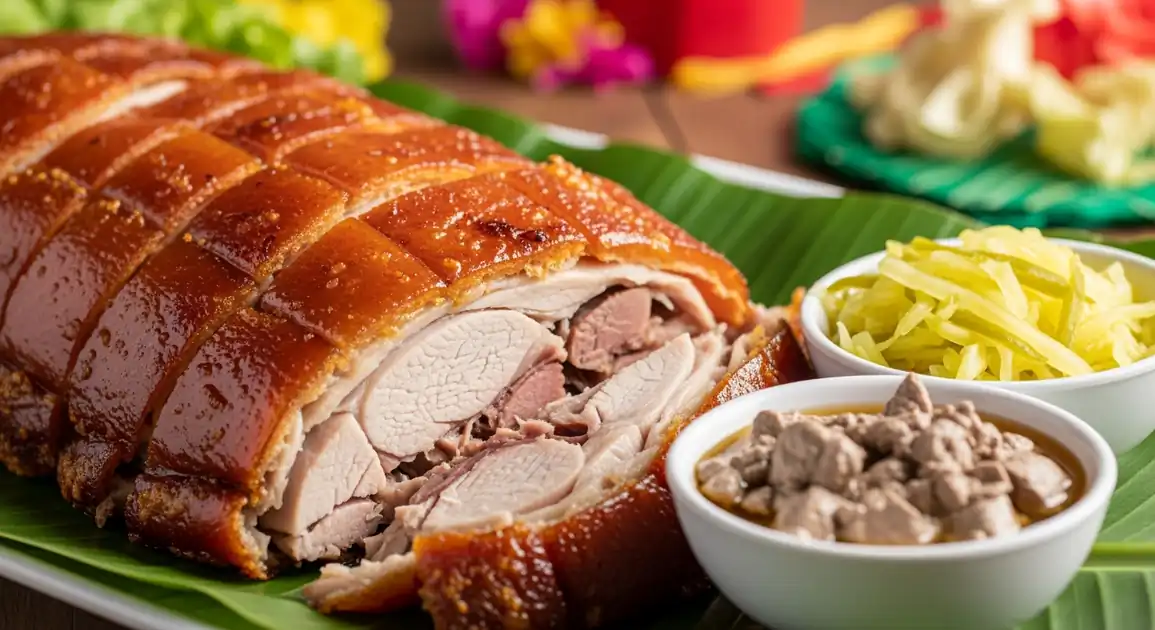
A Culinary Snapshot
Lechon, derived from the Spanish word for roasted suckling pig, is arguably the national dish of the Philippines, a culinary masterpiece and the undisputed centerpiece of Filipino celebrations and fiestas. It involves meticulously spit-roasting a whole pig over charcoal for hours, a process that demands constant attention and skill. The goal is to achieve a perfect golden-brown crispiness for the skin ('balat'), which crackles with every bite, while ensuring the meat inside ('laman') remains incredibly tender, juicy, and bursting with savory flavor. This iconic dish embodies the spirit of Filipino hospitality and communal feasting.
Crafting the Perfect Dish
Preparation involves selecting a suitable pig, cleaning it thoroughly, and seasoning it. Cebu style involves stuffing the cavity with a blend of herbs and spices (lemongrass, garlic, onions, salt, pepper). Manila style often has simpler seasoning. The pig is skewered on a bamboo pole and manually or mechanically rotated over a bed of hot charcoal for several hours. Constant basting (sometimes with liquids like soy sauce or even milk) helps achieve the signature crispy skin. Carving is also an art, often done publicly at the point of sale or during feasts.
Key Ingredients of Lechon (Roasted Pig)
Pork (Baboy)
The quality of the pig is paramount. Young, healthy pigs, often suckling pigs (cochinillo) for special occasions, are preferred for their tender meat and delicate skin.
Quality indicator: Look for pigs that appear well-fed and healthy, sourced from reputable farms or suppliers, ensuring the meat is fresh and free from blemishes.
Aromatics (Pampalasa)
For Cebu-style Lechon, the cavity is generously stuffed with a blend of fresh lemongrass, garlic, onions, and sometimes star anise or bay leaves. These infuse the meat with deep, aromatic flavors.
Quality indicator: The aromatics should be fresh, vibrant, and fragrant, indicating their potency and ability to impart maximum flavor to the pork.
Salt and Pepper
These basic seasonings are crucial for flavoring the meat, both inside the cavity and externally. They draw out moisture and contribute to the crispy skin.
Quality indicator: Ensure high-quality, coarse sea salt and freshly ground black pepper are used, as their purity and texture significantly impact the final taste and skin crispiness.
Classic Pairings for Lechon (Roasted Pig)
Steamed White Rice
staple
The neutral flavor and soft texture of plain steamed white rice perfectly complement the rich, savory, and often fatty Lechon. It helps balance the meal and absorb the delicious juices.
Lechon Sarsa (Liver Sauce)
sauce
A thick, sweet, and tangy liver-based sauce, often served with Manila-style Lechon. Its rich umami flavor and slight sweetness cut through the pork's richness, enhancing the overall experience.
Atchara (Pickled Green Papaya)
side dish
This sweet, sour, and crunchy pickled green papaya salad provides a refreshing contrast to the fatty Lechon. Its acidity acts as a palate cleanser, preparing your taste buds for the next savory bite.
From Humble Origins: A Brief History
The tradition of roasting pigs in the Philippines predates Spanish colonization, with indigenous communities having their own methods of preparing whole animals for feasts. However, the specific "Lechon" tradition as known today, including its name and the grand scale of its preparation, has significant Spanish influence, merging pre-colonial roasting techniques with European fiesta culture. Over centuries, Lechon became deeply ingrained as a powerful symbol of hospitality, celebration, and community gathering throughout the archipelago. This evolution led to the development of distinct regional variations, such as the famously flavorful Cebu style and the sauce-centric Manila style, each reflecting local culinary preferences and traditions.
Local Lechon (Roasted Pig) Variations in Philippines
Lechon Baboy
This is the quintessential whole roasted pig, the most traditional and widely recognized form of Lechon. It's prepared by spit-roasting an entire pig over an open fire, resulting in its signature crispy skin and succulent meat. It's the centerpiece of any major Filipino celebration.
Lechon Belly / Porchetta
This variation features a deboned, rolled pork belly, seasoned with similar aromatics to whole Lechon, then slow-roasted. It offers an intense focus on the prized crispy skin and the rich, fatty layers of the belly, providing a concentrated burst of flavor and texture.
Lechon Manok
While not pork, "Lechon Manok" refers to whole roasted chicken, typically marinated in a savory-sweet blend of spices and cooked on a rotisserie. It shares the "Lechon" name due to the roasting method and its popularity as a more accessible, everyday roasted dish.
Cochinillo
This refers to a roasted suckling pig, specifically a very young piglet. Cochinillo is prized for its exceptionally tender, almost melt-in-your-mouth meat and incredibly delicate, paper-thin crispy skin. It's often considered a gourmet or specialty item, typically found in high-end restaurants or for very special occasions.
Lechon Kawali
Unlike other Lechon variations, Lechon Kawali is deep-fried pork belly chunks, not roasted. The pork is boiled until tender, then deep-fried to achieve an intensely crispy skin and tender, juicy meat. It's typically served as a standalone dish with a vinegar-based dipping sauce.
Spotting Quality: What to Look For
What to Look For
-
Incredibly crispy, crackling skin
This is the primary indicator of freshly roasted, high-quality Lechon. Soggy skin means it's old or improperly stored.
-
Moist, juicy-looking meat
The meat should not appear dry or tough. Look for visible succulence when carved.
-
Vendor carves from a whole pig upon ordering
Ensures greater freshness compared to pre-carved portions sitting out.
-
High customer turnover
Busy stalls sell Lechon quickly, ensuring the product doesn't sit for too long.
-
Clean serving area and utensils
Basic food hygiene is crucial. Check for clean chopping boards, knives, and serving practices.
What to avoid
-
Soggy, rubbery, or soft skin
Indicates the Lechon is old or has been stored improperly, losing its essential crispiness.
-
Dry, stringy-looking meat
Suggests overcooking or that the Lechon has been sitting for too long.
-
Pre-carved portions sitting uncovered at room temperature for extended periods
This practice compromises the quality and freshness of the meat, making it less desirable for consumption, especially in warm climates.
-
Visible flies or pests around the food
The presence of flies or other pests is a clear sign of poor hygiene. Prioritize vendors who actively keep their food covered and protected to ensure optimal quality.
-
Vendor handles money then food without washing hands/changing gloves
This practice indicates a lack of attention to food handling standards, which can compromise the quality of the dish.
Explore Lechon (Roasted Pig) in Detail: City Guides
Discover where to find the best Lechon (Roasted Pig) and learn local tips in these cities:
Dietary Information
Dietary Information
Important Note for Travelers: Your safety is our priority. Below are the common allergens associated with the traditional preparation of this dish. However, recipes and ingredients can vary significantly between establishments. Always confirm all ingredients directly with the food vendor before ordering, especially if you have a severe allergy.
Potential Allergens
Dietary Suitability
How to Order Lechon (Roasted Pig)
Frequently Asked Questions about Lechon (Roasted Pig)
What is Lechon?
Lechon (or Litson) is a whole roasted pig, a highly popular dish in the Philippines. It involves slow-roasting a whole pig (Lechon Baboy) over charcoal, resulting in incredibly crispy, golden-brown skin (balat) and moist, flavorful meat (laman). It's a centerpiece of Filipino celebrations.
What's the difference between Cebu Lechon and Manila Lechon?
The main difference lies in seasoning and reliance on sauce. Cebu Lechon is typically stuffed with herbs like lemongrass (tanglad), garlic, spring onions, and peppers, making it flavorful enough to eat without sauce. Manila Lechon often has simpler seasoning and traditionally relies heavily on a sweet and tangy liver-based dipping sauce ('sarsa').
How can I ensure I'm choosing quality Lechon?
To ensure you're selecting high-quality Lechon, prioritize vendors with high customer turnover, as this indicates freshness. Look for incredibly crispy skin and moist, succulent meat. Be discerning about portions that have been sitting uncovered for extended periods, especially in warm, humid environments, as their quality may be compromised.
What is Lechon typically served with?
Lechon is often served with steamed white rice. Cebu-style Lechon is often eaten as is, while Manila-style is almost always served with a thick, sweet liver sauce (like Mang Tomas brand or homemade). Pickled green papaya ('atchara') is a common side dish to cut through the richness.
Is Lechon gluten-free?
The Lechon meat and skin itself are naturally gluten-free. However, the traditional liver sauce often contains breadcrumbs or flour as a thickener, making the sauce *not* gluten-free. Always check sauce ingredients if you have celiac disease or gluten sensitivity.
When is Lechon typically eaten?
Lechon is available year-round but is indispensable during fiestas, holidays (especially Christmas and New Year), birthdays, weddings, and any significant celebration. It symbolizes festivity and abundance.
Expert How-To Guides about Lechon (Roasted Pig)
How to Spot Good Quality Lechon
Learn to identify fresh, high-quality Lechon by observing key visual and textural characteristics, ensuring you get the best possible experience.
- Check the Skin: Look for uniformly golden-brown, blistered, and extremely crispy skin ('balat'). It should crackle when touched or cut. Avoid soggy, chewy, or overly dark/burnt skin.
- Assess Meat Moisture: The meat ('laman') underneath should look moist and succulent, not dry or stringy.
- Observe Carving: Ideally, buy from vendors carving fresh portions from a whole pig rather than pre-cut pieces sitting out.
- Look for High Turnover: Busy vendors usually indicate freshness as the Lechon sells quickly.
- Vendor Reputation: Choose well-known Lechon houses or stalls recommended by locals.
- Cleanliness: Ensure the serving area and utensils are clean.
How to Best Enjoy Eating Lechon
Discover practical tips and traditional customs to fully appreciate and maximize your Lechon eating experience, from first bite to last.
- Eat the Skin First (or Quickly): The crispy skin ('balat') is the most prized part. Eat it immediately while it's at peak crispiness before it softens.
- Pair with Rice: Lechon is rich; eating it with plain steamed rice helps balance the flavors and richness.
- Use Sauce Appropriately: Try Cebu Lechon without sauce first to appreciate its inherent flavor. Use liver sauce generously with Manila-style Lechon.
- Add Atchara: Use pickled papaya ('atchara') as a palate cleanser between rich bites.
- Try Different Parts: Sample both the crispy skin and the juicy meat from different sections (like belly vs. shoulder) for varying textures and flavors.
- Share!: Lechon is a communal dish, best enjoyed with friends and family.
Understanding Regional Lechon Styles (Cebu vs. Manila)
Understand the distinct characteristics of Cebu and Manila Lechon styles to help you choose which regional flavor profile best suits your palate.
- Cebu Style (Visayas): Focuses on aromatics stuffed inside the pig (lemongrass, garlic, herbs, salt, pepper). Meat is inherently flavorful. Typically eaten *without* liver sauce. Skin is famously crispy.
- Manila Style (Luzon): Simpler internal seasoning. Flavor relies heavily on the external basting and especially the mandatory thick, sweet, tangy liver dipping sauce ('sarsa').
- Other Regions: Variations exist, some leaning towards Cebu style (like in Bohol), others having unique local stuffings or sauces.
Our Commitment to Quality
At Tasteplorers, our mission is to provide the most accurate and useful travel information in the world. To achieve this, all content on this site is created through our unique editorial framework. We utilize leading AI research tools, guided by our proprietary prompts, and a multi-stage validation process. This entire system is overseen by our editorial team to ensure everything we publish meets our high standards for accuracy, cultural nuance, and practical value for travelers.
Learn more about our Editorial Process and our Mission.
Countries
Explore regions
Europe
Discover Europe's diverse culinary landscape, from Mediterranean flavors to hearty Alpine fare. Learn to navigate markets, decode menus, and eat like a local.
Latin America & Caribbean
Discover the vibrant cuisines of Latin America & the Caribbean. Our expert guide covers everything from Mexican street food to Peruvian ceviche and market tips.
Oceania
Explore Oceania's diverse food scene. Learn about Polynesian earth ovens, Fijian feasts, and the vibrant café culture of Australia and New Zealand.
Southeast Asia
Explore Southeast Asia's diverse food cultures from Thailand to Vietnam. Get expert tips on navigating spice levels, choosing quality vendors, and understanding the rich traditions of the region.
